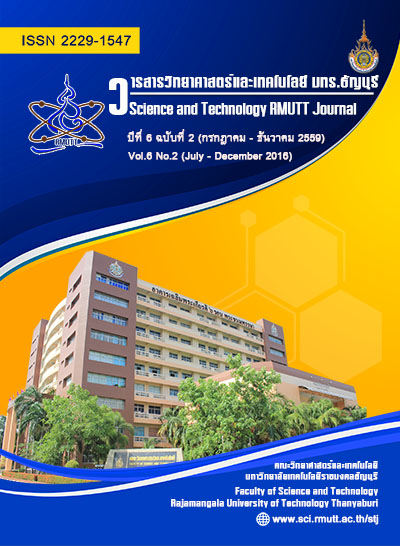Anti-bacterial and Anti-quorum Sensing Properties of Selected Medicinal Plants from Nakhon Ratchasima Province, Thailand
Main Article Content
Abstract
Quorum sensing (QS) is an intercellular signaling system and gene regulatory mechanism used by bacteria to respond to their cell population. Several physiological processes in pathogenesis of medically important bacteria are associated with this system. As QS controls bacterial virulence factors, the inhibition of the system is being considered as a novel approach for antibacterial substance. Hence, the present study was determined the effect of 48 Thai medicinal plant species on bacterial QS, Chromobacterium violaceum. Screening test using disc diffusion assay showed that five plant extracts exhibited anti-QS activity including Alpinia galanga Sw., Feronia limonia (L.) Swing, Millingtonia hortensis Linn., Oroxylum indicum (L.) Kurz., and Sesbania grandiflora (L.) Poiret. All extracts, except A. galanga, reduced strong violacein production. The sixteen extracts from 60 plant extracts which exhibited an antibacterial activity, were than determined minimal inhibitory concentration (MIC) and was observed the violacein production. The extract of A. galanga and P. betle gave MIC values at 5 and 1.25 mg/ml, respectively. In addition, the two extracts also possessed an anti-QS activity at sub-MIC. The results reveal the mode of action of botanical plants including anti-QS property and this activity should be further examinations.
Article Details
References
C.M. Waters & B.L. Bassler. Quorum sensing: cell-to-cell communication in bacteria. Annu Rev Cell Dev Biol. 21 (2005): 319-346.
Y.H. Dong & L.H. Zhang. Quorum sensing and quorum-quenching enzymes. J Microbiol. 43 (2005): 101-109.
V.C. Kalia. Quorum sensing inhibitors: an overview. Biotechnol Adv. 31 (2013): 224-245.
J. Pan & D. Ren. Quorum sensing inhibitors: a patent overview. Expert Opin Ther Pat. 19 (2009): 1581-1601.
H.C. Lichstein & V.F. Van De Sand. The antibiotic activity of violacein, prodigiosin, and phthiocol. J Bacteriol. 52 (1946): 145-146.
R.J. McLean, L.S. Pierson, & C. Fuqua. A simple screening protocol for the identification of quorum signal antagonists. J Microbiol Methods. 58 (2004): 351-360.
D.A. Vattem, K. Mihalik, S.H. Crixell, & R.J.C. McLean. Dietary phytochemicals as quorum sensing inhibitors. Fitoterapia. 78 (2007): 302-310.
H.S. Vasavi, A.B. Arun, & P.D. Rekha. Inhibition of quorum sensing in Chromobacterium violaceum by Syzygium cumini L. and Pimenta dioica L. Asian Pac J Trop Biomed. 3 (2013): 954-959.
A.L. Harvey. Natural products in drug discovery. Drug Discov Today. 13 (2008): 894-901.
K.S. Lam. New aspects of natural products in drug discovery. Trends Microbiol. 15 (2007): 279-289.
A.L. Adonizio. Anti-quorum sensing agents from South Florida medicinal plants and their attenuation of Pseudomonas aeruginosa pathogenicity. J Ethnopharmacol. 105 (2008): 427–435.
Clinical and Laboratory Standards Institute: CLSI. Methods for dilution antimicrobial susceptibility tests for bacteria that grow aerobically; Approved standard, 8th ed. Clinical and Laboratory Standards Institute document M07-A8. Wayne, PA, Laboratory Standards Institute. 2009.
C.H. Yang & Y.H. Li. Chromobacterium violaceum infection: A clinical review of an important but neglected infection. J Chin Med Assoc. 74 (2011): 435-441.
I.M. Scott, H.R. Jensen, B.J. Philogène, & J.T. Arnason. A review of Piper spp. (Piperaceae) phytochemistry, insecticidal activity and mode of action. Phytochem Rev. 7 (2008): 65-75.
K.N. Akter, P. Karmakar, A. Das, S.N. Anonna, S.A. Shoma, & M.M. Sattar. Evaluation of antibacterial and anthelmintic activities with total phenolic contents of Piper betel leaves. Avicenna J Phytomed. 4 (2014): 320-329.
S. Limsuwan, & S.P. Voravuthikunchai. Anti-Streptococcus pyogenes activity of selected medicinal plant extracts used in Thai Traditional Medicine. Trop J Pharm Res. 12 (2013): 535-540.
L.Y. Tan, W.F. Yin, & K.G. Chan. Piper nigrum, Piper betle and Gnetum gnemon-Natural Food Source with Anti-Quorum Sensing Properties. Sensors. 13 (2013): 3975-3985.
P. Kawsud, J. Puripattanavong, & R. Teanpaisan. Screening for Anticandidal and Antibiofilm Activity of Some Herbs in Thailand. Trop J Pharm Res. 13 (2014): 1495-1501.
A.K. Chudiwal, D.P. Jain, & R.S. Somani. Alpinia galanga Willd.-An overview on phyto-pharmacological properties. Indian J Nat Prod Resour. 1 (2010): 143-149.
K. Rao, B. Ch, L.M. Narasu, & A. Giri. Antibacterial activity of Alpinia galanga (L) Willd crude extracts. Appl Biochem Biotechnol. 162 (2010): 871-88.


